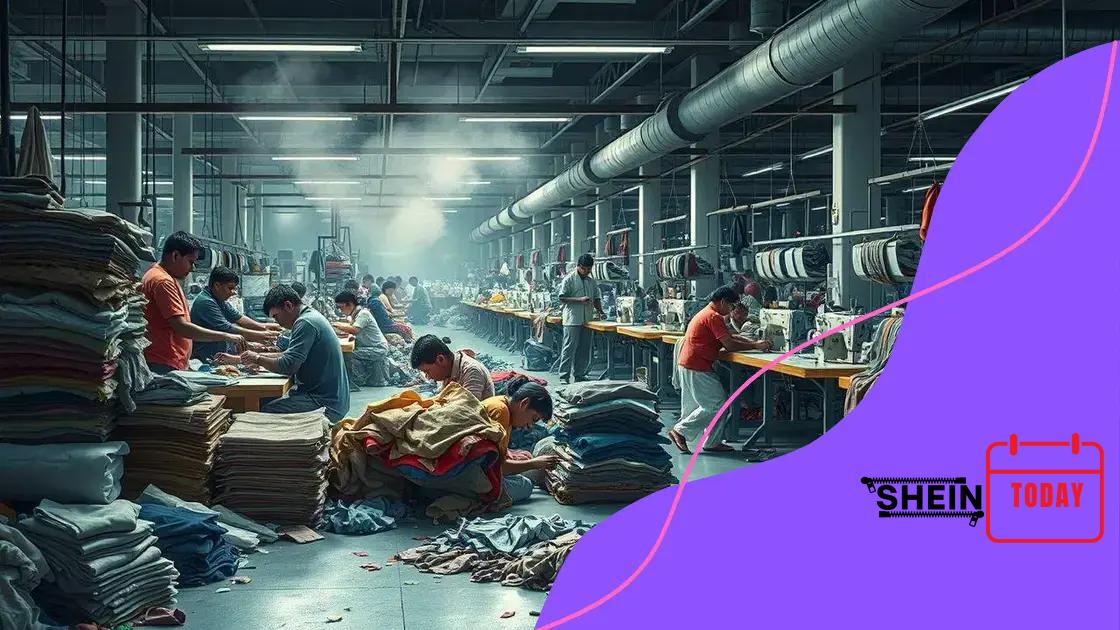How Shein is shaping fast fashion in 2025

How Shein is shaping fast fashion in 2025 involves rapid style turnover, influencer marketing, and a growing focus on sustainability as consumer demands evolve.
How Shein is shaping fast fashion in 2025 sparks curiosity about a brand that’s redefining the industry. Have you ever wondered how a company so young could dominate such a massive market? Let’s dive into the innovative strategies that are transforming fashion today.
The rise of Shein and its impact on fashion
The rise of Shein has been nothing short of phenomenal. In just a few years, it transformed from a lesser-known brand into a leading player in the fast fashion industry. What’s behind this growth? Let’s explore the factors that propelled Shein to the forefront of fashion.
One key factor is understanding its target audience. Shein has tailored its offerings specifically for young shoppers. By focusing on social media marketing and data-driven decisions, Shein quickly adapted to trends favored by this demographic.
Marketing Strategies That Work
Shein excels in using innovative marketing techniques. Their tactics include:
- Influencer Collaborations: Partnering with influencers boosts visibility and credibility.
- Flash Sales: Limited-time offers create urgency and excitement.
- Trendy Designs: Fast turnaround on new styles keeps shoppers engaged.
- User-Generated Content: Encouraging customers to share their looks promotes community.
Additionally, Shein has embraced technology to streamline operations and enhance customer experience. The use of analytics helps predict which styles will sell, allowing them to stock popular items effectively.
Another crucial aspect of Shein’s impact on the fashion world is its pricing strategy. By offering fashionable clothing at affordable prices, they have attracted a broad audience. This model challenges traditional retailers and pushes them to reconsider their pricing structures.
Consumer Behavior Changes
Shein has also influenced how consumers shop. The ease of shopping online, combined with the variety of available styles, has transformed shopping habits. Buyers now seek instant gratification, wanting to see new styles daily.
These changes hint at a larger trend in the fast fashion industry. Other brands are now competing not just on style but on speed and price. The lasting impact of Shein’s rise is reshaping expectations across the board.
As Shein continues to grow, its impact on fashion is undeniable. Competing brands must adapt to the new normal or risk being left behind. There’s no telling how far Shein will go, but its influence is set to linger in the industry.
Fast fashion trends emerging from Shein
The fast fashion trends emerging from Shein are fascinating and transformative. As Shein grows, it shapes the preferences and buying behaviors of shoppers globally. Understanding these trends is essential for brands that want to remain competitive in the ever-evolving fashion landscape.
One significant trend is the quick turnover of styles. Shein introduces new items daily, which keeps the shopping experience fresh and exciting for consumers. This model encourages impulse buying, as shoppers feel pressure to purchase items before they sell out.
Specific Style Trends
Several specific style trends have gained traction thanks to Shein:
- Seasonal Themes: Styles often reflect upcoming seasons, helping buyers stay on-trend.
- Mix and Match: Shein promotes versatility with pieces that can be styled in multiple ways.
- Inclusivity in Sizes: The brand has expanded its size range, appealing to a broader audience.
- Streetwear Influence: Casual and laid-back styles dominate, resonating with younger shoppers.
Additionally, Shein’s use of social media to showcase these trends cannot be understated. Platforms like Instagram and TikTok allow users to see real people wearing the brand’s items. This visibility creates a sense of community and authenticity that customers crave.
Another emerging trend is sustainability awareness. Although Shein’s rapid production model faces criticism, there is a growing push for sustainable practices. Customers are starting to demand more eco-friendly options, prompting Shein to explore initiatives for greener production methods.
Overall, the trends stemming from Shein reflect a shifting landscape in the fashion industry. Other brands must pay attention to consumer desires for speed, variety, and increasingly, sustainability, to stay relevant in the market.
Sustainability challenges in Shein’s model

The sustainability challenges in Shein’s model are increasingly scrutinized as the brand grows. With the rise of fast fashion, consumers are becoming more aware of the environmental impact of their buying choices. Shein’s rapid production and low-cost strategies raise questions about sustainability and ethical practices.
A major concern is the environmental footprint of fast fashion. Shein’s business model, which relies on quick turnarounds and constant new styles, contributes to excessive waste. Many garments produced may end up in landfills shortly after purchase, fostering a throwaway culture.
Key Sustainability Issues
Some key sustainability issues associated with Shein include:
- Resource Consumption: The production of cheap clothing requires significant resources, from water to energy.
- Labor Practices: There are ongoing concerns about working conditions in factories producing Shein’s items.
- Carbon Emissions: Fast fashion brands like Shein often have high carbon footprints from manufacturing and distribution.
- Microplastics: Many garments are made from synthetic materials that contribute to microplastic pollution.
In response to these challenges, Shein has begun to explore sustainability initiatives. For instance, they are looking into more sustainable materials and promoting recycling programs. While these steps are positive, critics argue that genuine commitment to sustainability requires more substantial changes.
Moreover, the pressure to deliver trendy items quickly often undermines sustainability efforts. Balancing consumer demand for fresh styles with environmental responsibilities remains a significant hurdle for Shein and similar brands. Without deeper systemic changes, the fast fashion industry will continue to face criticism concerning sustainability.
Marketing strategies that drive Shein’s success
The marketing strategies that drive Shein’s success are pivotal to its rapid rise in the fast fashion industry. Shein employs various innovative tactics to engage younger consumers and expand its market reach effectively. By leveraging technology and social media, the brand has positioned itself as a recognizable name in fashion.
One of the standout strategies is Shein’s focus on influencer marketing. By collaborating with popular social media influencers, Shein taps into their followers, who trust their recommendations. This strategy enables Shein to effectively showcase its latest collections and create buzz around new releases.
Digital Engagement Techniques
In addition to influencer partnerships, Shein excels at engaging customers through digital platforms:
- Social Media Campaigns: Active presence on platforms like Instagram, TikTok, and Pinterest lets Shein connect directly with its audience.
- User-Generated Content: Encouraging customers to share photos wearing Shein products fosters a sense of community and authenticity.
- Flash Sales and Promotions: Frequent limited-time offers generate urgency and encourage quick purchases.
- Interactive Features: Tools such as style quizzes and augmented reality try-ons enhance the shopping experience.
Moreover, Shein effectively uses data analytics to understand consumer behavior. By analyzing shopping patterns, the brand can better predict trends and manage inventory efficiently. This data-driven approach ensures that Shein delivers styles that its customers want at the right time.
Another unique aspect of Shein’s marketing is its emphasis on affordability. The brand markets itself as a provider of trendy clothing at low prices. This appeal attracts a wide range of shoppers who are looking for stylish options without a hefty price tag.
Overall, Shein’s marketing strategies are multifaceted and targeted. By combining influencer collaborations, social media engagement, and data analysis, Shein continues to thrive in a competitive marketplace. Brands that wish to succeed must take notes from Shein’s dynamic approach and adapt innovative strategies to meet the changing demands of consumers.
The future of fast fashion post-Shein
The future of fast fashion post-Shein will likely be influenced by changing consumer expectations and the industry’s response to sustainability concerns. As Shein continues to grow, it sets a benchmark for other brands, making it essential to consider what lies ahead in this fast-paced market.
One of the most significant shifts is the increasing demand for ethical practices. Consumers are becoming more conscious of how their clothing is produced. Brands will need to adapt by implementing fair labor practices and adopting sustainable materials. The pressure is on to balance cost and environmental responsibility.
Emerging Trends in Fast Fashion
Some key trends that may shape the future include:
- Technological Integration: Advanced technologies like AI and machine learning will help brands anticipate fashion trends and manage inventory.
- Customization: Offering personalized shopping experiences could become a common expectation, allowing consumers to shape their clothing choices.
- Sustainable Collections: Brands may need to launch collections that prioritize eco-friendly fabrics and transparent supply chains.
- Second-Hand Market Growth: Interest in thrift shopping and second-hand clothing may continue to rise, encouraging brands to explore resale opportunities.
Moreover, the influence of social media will persist, playing a crucial role in shaping trends. As platforms evolve, brands will have to stay agile and responsive to the changing landscape of consumer engagement. With the younger generation leading the charge for change, companies will need to embrace new marketing strategies that resonate with their values.
Post-Shein, it seems likely that the fast fashion industry will face both challenges and opportunities. Those who can innovate while honoring sustainability will likely thrive in this new era of fashion. The focus on responsible practices is not just a trend; it’s becoming essential for survival in this market.
FAQ – Frequently Asked Questions about Fast Fashion and Shein’s Impact
What does the future hold for fast fashion after Shein?
The future will likely focus more on sustainability and ethical practices, as consumers demand responsible production.
How is consumer behavior changing in the fast fashion industry?
Consumers are becoming more aware of environmental impacts and are seeking brands that prioritize ethics and sustainability.
What role does technology play in the future of fashion?
Technology, including AI and data analytics, will help brands predict trends and manage inventory efficiently, transforming the shopping experience.
Can fast fashion brands adopt sustainable practices?
Yes, many brands are starting to explore sustainable materials and practices to meet consumer expectations for eco-friendly options.





